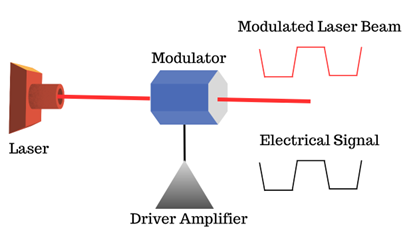Optical amplifiers and modulators play an essential role in how data and information are rapidly transferred in a growing, interconnected, and interdependent world. Therefore, advancements in the performances of these two optical components are critically important to accommodate the growing networks of optical communication structures.

Image Credit: Zyabich/Shutterstock.com
An optical modulator is a tool that may be used to change a characteristic of light. Frequently an optical beam, such as a laser beam's, properties are modified. Modulation of various laser beam properties can be affected. For example, they can be intensity modulators, phase modulators, polarization modulators and spatial light modulators, depending on which aspect of light is modulated. Some descriptions of modulators are listed below:
- Acousto-optic modulator - The acousto-optic effect of particular materials are used in this modulation. They are used to change a laser beam's optical frequency, its spatial direction, or its amplitude on-demand or constantly.
- Interferometric modulators - Most interferometric modulators, like Mach-Zehnder modulators, make use of interference and the electro-optic effect. They are widely used in photonic integrated circuits for optical data transfer.
- Electroabsorption modulators - These modulators are semiconductor-based intensity modulators that are employed in optical fiber communications for data transmitters, among other applications.
- Electro-optic modulators - The electro-optic effect in a Pockels cell is utilized by electro-optic modulators. In the context of ultrashort pulse amplifiers, they may be utilized for pulse picking in addition to changing the polarization, phase, or power of a beam.
Operation of an Optical Modulator
During optical modulation, laser light is subjected to an electrical signal by an optical modulator, which changes the laser’s power and phase to produce an optical signal. An electrical signal is changed into an optical signal by the optical modulator because the applied voltage can alter the phase and intensity of the beam.
An illustration of an optical modulator is shown in Figure 1. The optical modulator receives the signal-free laser light produced by and transforms it into an optical signal using the electrical signal from the driving amplifier. A high-output driver amplifier is employed to drive the optical modulator because a high-voltage electrical signal is needed to drive the modulator.
According to the most recent international communication standards, communication rates are continually rising, necessitating driver amplifiers with high power and quick operation.
Silicon, which is inexpensive and simple to shape into large-scale integrated circuits, is the most widely used semiconductor material. Unfortunately, silicon is not suited for use as a driver amplifier semiconductor material since it is challenging to produce both a fast operating speed and high output using silicon.

Figure 1: Optical Modulator
Driver amplifiers are typically compound semiconductors made from two or more components. Compound semiconductors are the best choice for use in driver amplifiers that need both fast speed and high output because of their high electron mobility and wide bandgap.
Another benefit is the capability of synthesizing layers of compound semiconductor materials with various combinations of elements and composition ratios to realize fast transistors. Some examples of such transistors are heterojunction bipolar transistors (HBT) and high electron mobility transistors (HEMT). Gallium nitride (GaN), gallium arsenide (GaAs), silicon germanium (SiGe) andindium phosphide (InP) are examples of common compound semiconductor materials.
GaAs, InP, and SiGe, are suitable for manufacturing driver amplifiers supporting the Ethernet standards for optical communications, which control speeds of 100 and 400 Gbps. Future communication infrastructure is expected to reach rates of 800 Gbps. Different compound semiconductors have distinctive qualities applicable to different requirements. SiGe with a big diameter can be produced at a cheap cost using standard silicon semiconductor methods, but it is challenging to produce this material to operate at high rates.
Although GaAs is frequently employed in systems with high output and high speeds, it has limitations in handling future communication rates that would be needed for operating frequencies of 70 GHz or more, which are needed for 800-Gbps Ethernet. InP is an ideal semiconductor material for cutting-edge optical driver amplifiers enabling future high-speed communications because its transistors can be operated faster than GaAs.
Optical Amplifiers
At a wavelength in the 1,550 nm range, the transmission loss of the light flowing through an optical fiber is less than 0.2 dB per kilometer. The transmission loss, however, cannot be disregarded when the optical fiber length covers up to 100s of kilometers. An optical amplifier is required when the optical signal traveling through a long-distance optical cable gets very weak.
A crucial component of modern long-distance optical communication networks, an optical amplifier, amplifies the optical signal. The three main categories of optical amplifiers are:
- Erbium-Doped Fiber Amplifiers (EDFA) - Erbium ions are introduced to the optical fiber's core in an optical amplifier called an EDFA, one form of OFA. It is polarization independent, has high gain and low noise, and can be applied to optical signals in the 1.55 m or 1.58 m bands.
- Fiber Raman Amplifier (FRA) - In an FRA, as soon as powerful excitation light reaches the optical fiber, it results in stimulated emission based on Stimulated Raman scattering. The light is then amplified over a wavelength range that is approximately 100 nm longer than the wavelength of the excitation light. The excitation light's wavelength may be used to flexibly adjust its wide range of amplification wavelengths.
- Semiconductor Optical Amplifier (SOA) - A semiconductor element, as implied by the name, is what a SOA is. Light signal is enhanced by stimulated emission by performing anti-reflective processing within a semiconductor cavity.
Future Outlook
Optical modulators and Amplifiers, as described in this report, play a crucial role in advancing and accommodating the growing networks of optical communications. More conducive materials and enhanced control systems are continuously being developed to increase the performance of such components. For example, an SOA may be manufactured in a small footprint, and it is more economically efficient than an EDFA due to its reduced operating expenses. The input light of an SOA is extremely polarization dependent until recent years, although research into reduced polarization dependence has advanced recently. Additionally, SOAs are replacing EDFAs in data centers, and their application in optical communication is anticipated to grow in the future.
More from AZoOptics: 3D and 4D Machine Vision Solutions from SiLC
References and Further Reading
Anritsu - Optical Device Guide. Various Optical Amplifiers (EDFA, FRA, and SOA) | antristsu.com. Available at: https://www.anritsu.com/en-au/sensing-devices/guide/optical-amplifier
Anritsu - Electronic Devices Guide. Optical Modulator Driver Amplifiers and Semiconductor Materials | antristsu.com. Available at: https://www.anritsu.com/en-gb/sensing-devices/guide/amp-semiconductor-material
Paschotta, R. Recent Developments in Optical Semiconductors. [Online] rp-photonics.com. Available at: https://www.rp-photonics.com/optical_modulators.html
Disclaimer: The views expressed here are those of the author expressed in their private capacity and do not necessarily represent the views of AZoM.com Limited T/A AZoNetwork the owner and operator of this website. This disclaimer forms part of the Terms and conditions of use of this website.